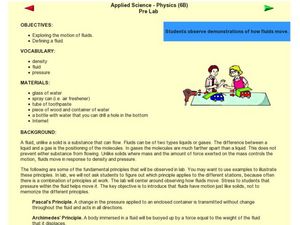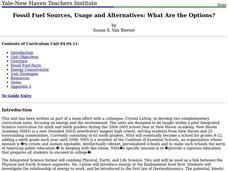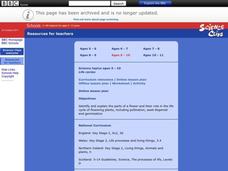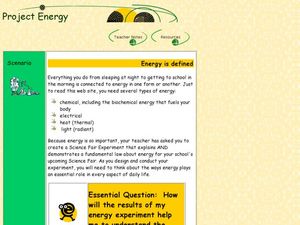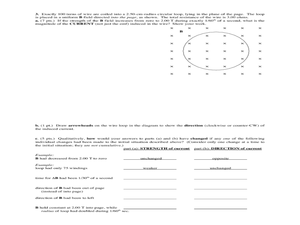Curated OER
Electricity/Magnetism
Fourth graders explore magnets as fundamental parts of generators and how they are used to produce current electricity. They distinguish between the north and south pole of magnets and the difference between repel and attract. Students...
Curated OER
Applied Science Physics Pre Lab
Students explore physics. In this magnetism instructional activity, students attempt to make a magnet out of a iron rod. They observe the teacher complete the procedure first and then try it themselves.
Curated OER
Current Thinking About Magnets
Students construct their own magnet and wire device. In this inquiry instructional activity, students investigate the factors affecting the strength of magnetic forces. They manipulate different variable to determine their effect.
Curated OER
Magnets and Springs
Students participate in an online lesson making and recording observations of magnets. They determine that magnets attract some metals but not others and that other materials are not attracted to magnets.
Curated OER
Life cycles
Students identify and explain the parts of a flower and their role in the life cycle of flowering plants, including pollination, seed dispersal and germination using the Internet. Students will also study and discuss the key points and...
Curated OER
Ocean Life
Students examine the fossil remains of ancient sea creatures. They create casts of fossils and identify how sea fossils are formed and consider what type of information fossils can give to scientists.
Curated OER
Wind Power
What a wonderful way to explore wind power! Through this lesson, learners get a background in the history of wind power, create their own wind turbine, and the test their designs. This is a terrific way to tie scientific principles to...
Curated OER
once and future MOON
Beyond the phases of the moon, this comprehensive lesson plan covers geologic history and geology. Amateur astronauts examine photos of the lunar landscape, experiment with the creation of craters, and delve into information about the...
Curated OER
Forms of Energy
Students complete a series of activities related to forms of energy. For this energy lesson, students look at forms of energy in their school, how energy is conserved and used efficiently, how magnets are used to generate electricity,...
Virginia Department of Education
Isotopes
Lead your class through the amazing world of isotopes as they investigate the various properties they contain and further understand their respective location on the periodic table. They explore half-lives and radioactivity as each...
Curated OER
What is the Attraction?
Second graders investigate the law of polarity. In this magnets instructional activity, 2nd graders discover how magnets are used in everyday life and which objects in our environment are magnetic. Students experiment with bar magnets...
Cornell Lab of Ornithology
Amazing Birds
What's so amazing about birds? Find out just how amazing birds are with a physics of animal behavior unit created by Cornell Lab of Ornithology. Have learners explore and tap into their observational skills and notice how birds fly, what...
Curated OER
Electromagnetic Pick-up
Students investigate electromagnetic energy. In this magnetism lesson, students will create an electromagnet and test changes with increased energy. They will compete by building the strongest electromagnet.
Curated OER
Fossil Fuel Sources, Usage and Alternatives: What are the Options?
Young scholars identify the different sources of fossil fuels. In this environmental science lesson, students research about how these impact our environment. They explore renewable energy sources that could replace fossil fuels.
US Department of Energy
The Ring Fling Machine
Class members build a machine to demonstrate Lenz's law and help this scientific principle come to life. After building a ring fling machine, instructions for properly operating the machine and a few thought-provoking questions lead to...
Curated OER
Cells: The Units of Life
In this biology worksheet on cells, 9th graders name who the first person was to use the word cell and describe in what materials this person saw cells. Then they determine what instrument uses light and two or more lenses to view cells.
Curated OER
Life Cycles
Students identify and explain the parts of a flower and their role in the life cycle of flowering plants. In this online plant biology lesson, students explore the processes of pollination, seed dispersal, and germination. Extension...
Curated OER
Is the Earth Preparing to Flip?
In this Earth's magnetic poles learning exercise, learners read about the changes observed in Earth's magnetic field and the possible geomagnetic reversal of the north and south magnetic poles. Students answer 5 questions about the...
Curated OER
Project Energy
Students explore multiple types of energy. In this energy instructional activity, students prepare a science fair project through completing a WebQuest. Students investigate radiant, thermal, and biochemical energy.
Curated OER
The Salmon Stream and Vegetation
Students explore the ecosystem and food chain by researching Pacific Salmon. In this fish habitat lesson, students discover the life cycle for salmon, where they spawn and what they eat to survive the harsh elements. Students participate...
Curated OER
Phytoplankton and Ocean Color
Fifth graders identify function of phytoplankton in the biospere by conducting experiments and simulations and reading for information. They detect the presence of phytoplankton in bodies of water by examining ocean in satellite images...
Curated OER
The Science of Ghana
Students explore the climate and food sources of Ghana. In this lesson on climate students view diagrams of global convection and complete a convection experiment.
Curated OER
Fall 2003 Midterm Exam #2
Your physics students will really shine when they take this midterm exam. It covers a variety of concepts dealing with electromagnetic spectra, electricity, and motors and it provides a variety of question styles.
K12 Reader
Galileo and His Telescope
Learn about Galileo Galilei's contribution to modern science with a reading passage that focuses on reading comprehension. After kids read several paragraphs about his life, they answer five questions about the information they have just...



